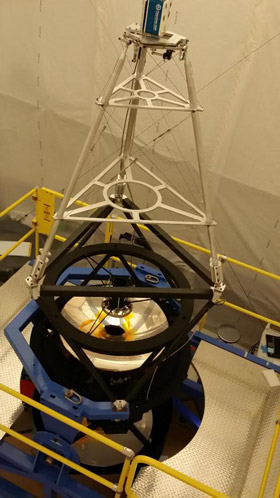Upgraded Hobby-Eberly Telescope Sees First Light
July 30, 2017
Project team prepares to test scientific instruments
After several years and a massive team effort, the upgraded Hobby-Eberly Telescope has achieved “first light,” taking its first images of the sky — a critical step on the path to beginning HETDEX and other leading-edge scientific experiments.
“This upgrade makes HET the most powerful wide-field spectroscopic telescope worldwide, and we expect unique scientific discoveries from it,” said Observatory director Taft Armandroff.

The upgrade was a major undertaking that included new optics, mechanical systems, and software. Today, HET essentially is a new telescope — only its primary mirror remains unchanged.
One key to the “new” HET is the wide-field corrector, which has been named the Harold C. Simmons Dark Energy Optical System. This set of optics sits above the telescope’s main mirror, and will focus the light from distant stars and galaxies onto the telescope’s scientific instruments. The system also allows the telescope to view a larger area of the sky with each observation, greatly increasing its efficiency.
Because it allows more of HET’s 10-meter by 11-meter mirror to be used, the system also makes HET a larger telescope. The mirror’s effective size has increased from 9.2 meters to 10 meters. This means that HET is now tied for the ranking of the world’s third-largest optical telescope.
The telescope also features a new tracker that supports the Simmons System (and a suite of instruments to ensure its alignment to extremely high precision) as it tracks cosmic targets across the sky. The tracker was built by The University of Texas at Austin Center for Electromechanics. A McDonald Observatory team led by Niv Drory developed HET’s entirely new control system.
The upgraded telescope is now able to track and guide on cosmic targets. The next step for the HET team is to complete commissioning of the telescope. Then the team will move on to commissioning HET’s three new science instruments.
“The revitalized HET will contribute to many areas of science,” said Larry Ramsey, chairman of the HET Board of Directors and professor at Penn State. “Not only the study of dark energy, but the nature of dark matter, the first stars in the universe, starburst galaxies, massive black holes, and to the discovery, confirmation, and characterization of extrasolar planets.”
